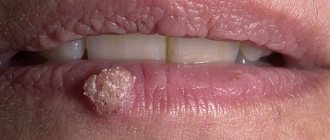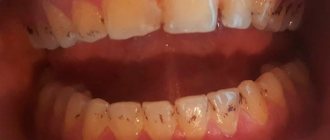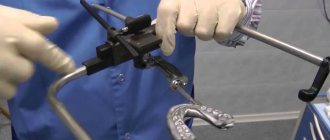Structure of the tonsils
The palatine tonsils, or tonsils, are an important organ of the human immune system. The tonsils are located in the oral cavity on both sides of the pharynx. The tonsils are shaped like an almond (hence the name “almond”) and range in size from one to four centimeters in diameter. The tonsils are endowed with a protective function. They are a kind of barrier to bacteria entering the body through airborne droplets, as well as through food intake. The structural features of the tonsils and the functions they perform are directly related to the appearance of tonsillitis plugs in the throat.
Make an appointment right now!
Call us by phone or use the feedback form
Sign up
On the surface of the tonsils, winding canals and openings are visible - lacunae and crypts.
When viruses from the outside enter the mouth, leukocytes in the tonsils are activated and begin an intensified process of forming antibodies that fight the “enemy.” At the same time, a signal is sent to all organs of the immune system, and the body comes into “combat readiness”.
Why do they appear?
There are several reasons for the appearance of cysts in the throat. For example, they can be genetically determined, and can often manifest themselves after a generation, notes Vladimir Zaitsev. Another point is problems with nasal breathing. “If it is absent, then the pharynx does not receive enough oxygen, a state of hypoxia develops, and the risk of developing cysts and polyps increases. Also, the reason may lie in the anatomical structure of the skull, when it develops atypically, which leads to a tendency to hypoxia of the nasopharynx. For example, when the soft palate sticks to the back wall of the pharynx and does not allow the nasopharynx to ventilate fully, this is also a precedent for the formation of tumors,” says the doctor.
“I believe cancer is contagious.” Oncologist - about the causes of this terrible disease Read more
What is tonsillitis?
Tonsillitis is an inflammatory process in the tonsils. The disease can be acute or chronic. The acute form is better known as tonsillitis. In chronic cases, periods of exacerbation (inflammation of the tonsils) are replaced by a period of remission (calm). Most often, the disease occurs in children 5-15 years old, although adults are also susceptible to the disease. The tonsils in children are larger than in adults. The palatine tonsils reach their maximum size by the age of 7, and then begin to shrink. Constant viral attacks on the tonsils lead to tonsillitis. Chronic tonsillitis most often acts as a complication after an infectious disease (sore throat, caries, etc.). The chronic form of the disease, according to statistics, occurs in 5% of adults and 11% of children. That is, chronic tonsillitis is a common disease. Tonsillitis plugs on the tonsils often appear with chronic tonsillitis.
Children's and adult ENT doctor, audiologist, otoneurologist, candidate of medical sciences, Budanov E.G.
Inflammatory diseases of the throat are one of the most common conditions that pediatric and adult ENT doctors encounter in their medical practice. The most commonly observed viral infections lead to pharyngitis or tonsillopharyngitis, which requires predominantly local and symptomatic treatment. However, in the age group of children over 4 years old, bacterial causes of acute, recurrent or chronic inflammation of both the throat itself and its tonsils will increasingly be observed. Bacterial infections of this localization are especially characteristic in primary and secondary school age up to 15 years. Many patients, having matured and graduated from school, stop complaining of regular inflammatory diseases of the throat, but in some adults such complaints persist. Among such patients, there are often those who are worried mainly by one main complaint - the frequent formation of the so-called. “plugs” on the palatine tonsils. From the stories of the patients, it follows that they had previously suffered from sore throats or severe pharyngitis with varying frequencies, or, on the contrary, did not have any distinct inflammatory diseases of the throat. At some point in time, they begin to experience sensations of a foreign body in the throat, possible discomfort, bad breath; upon self-examination of the throat, the formation of plaque, “lumps” or “plugs” on the palatine tonsils is noted. As a rule, patients try to remove them on their own: they intensively gargle, squeeze out these “plugs” from the tonsils using cotton swabs, a spatula, a regular spoon, etc. Despite these efforts, plugs in the tonsils form again and again. Some patients experience periodic or constant pain or a sensation of a lump in the throat, soreness and enlarged lymph nodes in the neck. Someone notices an increase in the number of plugs on the tonsils after colds, eating sweet or dairy foods. Often repeated or unsuccessful attempts to get rid of traffic jams lead the patient to an appointment with an ENT doctor or therapist. In this case, the task of the medical worker is to inform the patient about the reasons for his complaints, clarify all the accompanying circumstances and develop correct and effective treatment tactics to eliminate blockages on the palatine tonsils and prevent their occurrence. First of all, it is necessary to explain to the patient that tonsil plugs are not an independent disease, but one of the manifestations of deeper structural and functional changes that occur in the palatine tonsils due to the development of chronic infectious inflammation in them. The formation of plugs on the tonsils is based on the peculiarity of their structure, which consists in a well-developed system of depressions (niches or lacunae) on their surface, penetrating deeply into the tonsils. On the one hand, this provides a large contact surface for the effective functioning of the local immune system of the tonsils. On the other hand, with the development of long-term inflammation, which ultimately leads to cicatricial structural rearrangement of tissue, the lacunae become deformed and their lumen narrows. This leads to disruption of drainage and self-cleaning of lacunae during chewing and swallowing; food fragments actually remain in the lumen of the lacunae for a long time for days and weeks, becoming a breeding ground for bacteria. This leads to another predisposing factor - the presence of pathogenic microorganisms on the surface and in the lumen of the lacunae of the palatine tonsils, which settle on food fragments, forming a dense conglomerate around them, where the protective cells of the local immune system - leukocytes - rush. Gradually, a small conglomerate of “food-bacteria-leukocytes” increases, becomes denser, fills the entire lumen of the palatine tonsil lacuna and begins to protrude from its lumen on the surface visible to us when examining the throat. A large accumulation of bacteria and leukocytes causes an inflammatory reaction, which is manifested by a feeling of local discomfort, soreness, a feeling of a foreign body; it is also possible to develop a general inflammatory reaction with malaise, increased fatigue, and a slight persistent increase in body temperature. Understanding the mechanism and predisposing causes for the development of plugs on the palatine tonsils allows us to propose the correct treatment tactics. First of all, you should find out all the circumstances of the development of a persistent infection in the throat: perform a smear on microflora and sensitivity in order to select local and general antibacterial and antiseptic treatment, as well as to develop measures to prevent recurrence of the infection. It is necessary to establish all concomitant and predisposing factors that promote or aggravate local inflammatory processes in the throat: the state of immunity, the presence of concomitant autoimmune diseases or complications, the functional state of the heart, kidneys, blood vessels, joints, as target organs for complicated chronic infections in the throat, etc. d. The ENT doctor should evaluate the functional state of the palatine tonsils themselves in order to decide on the possibility of more gentle organ-saving treatment. Otherwise, if there are serious preconditions or consequences of a chronic infection in the throat, the question of removing the tonsils (tonsillectomy) is raised, when the very issue of treating “tonsil plugs” will be exhausted. In the case of possible preservation of the palatine tonsils and refusal of tonsillectomy, it is necessary to develop tactics of effective local and general treatment to achieve a lasting effect.
Treatment should include several points:
- It is necessary to eliminate the chronic bacterial infection, which underlies the inflammation and structural changes of the tonsils. For this purpose, information obtained from the results of a microbiological examination (smear) is used. Based on the obtained sensitivity to antibacterial drugs, effective local antibiotics and/or antiseptics are selected, which are used in the form of irrigation (gargling), in the form of sprays or as solutions for washing the lacunae of the tonsils, carried out by an ENT doctor. As a rule, these are solutions of chlorhexidine, miramistin, dioxidine, mestamidine, or plant origin - chlorophyllipt. The data obtained is also used for prevention. The patient may be recommended to apply local applications to the palatine tonsils of solutions or gels containing bacteriophages, including using the ultrasound method using the Tonzillor or similar apparatus.
- All of the approaches described above have their own therapeutic effect, but in most patients it is temporary and in the future there is a tendency to relapse in the formation of new plugs on the tonsils, since structural changes in the surface of the tonsils persist. This contributes to the re-accumulation of small fragments of food in the deformed and tortuous lumens of the lacunae with the repeated formation of conglomerates of bacteria and leukocytes around them. Therefore, at present, these methods should be considered as a preparatory stage for more effective treatment that gives a much more lasting effect, aimed at complete obliteration (closing) of the lumen of the tonsil lacunae. This procedure is called “lacunotomy” or “cryptolysis”, with its help it is possible to eliminate the mechanism of the emergence and accumulation of new plugs by targeted destruction of the input channels of the lacunae of the tonsils, ending with their sclerosis. For this purpose, a surgical instrument based on a laser or radio wave radiation is used, which makes it possible to provide an almost precise, stable dosed effect on the surface of the tonsil in the area of the lacunae. Subsequently, scar tissue forms in this place, which actually blocks the lumen for bacteria and food fragments to penetrate deep into the tonsils. Currently, lacunotomy is considered as an effective alternative to organ-preserving minimally invasive intervention to repeated washing of the tonsils or their removal.
- A competent, effective approach to local treatment of tonsil plugs can significantly improve the quality of life of patients with this condition. However, one should also take into account the general condition of the body, which is under a toxic and inflammatory load from chronic inflammation in the throat. It is necessary to take into account the state of immunity, establish the risks of developing autoimmune complications and rheumatic consequences of chronic tonsillitis, which underlies the formation of caseous plugs on the tonsils. Based on the total examination of the patient and his examination, consultation with an infectious disease specialist, rheumatologist, dentist, immunologist or other specialists, the appointment of anti-rheumatic prophylaxis and other therapeutic and preventive measures may be necessary. Limited treatment of local complaints alone cannot guarantee a lasting improvement in health status and the prevention of complications of chronic inflammatory diseases of the lymphoid formations of the upper respiratory tract.
Causes of chronic tonsillitis
The chronic form of tonsillitis often develops as a complication after a sore throat. Many patients try to cure a sore throat on their own and take medications uncontrollably. Some, having received doctor’s recommendations, do not follow the instructions and finish the course of taking antibacterial drugs earlier than expected, noticing an improvement. This is a huge mistake! Untreated sore throat causes the disease to enter the chronic stage and the formation of tonsillitis with purulent plugs. The main causative agents of the disease are streptococci and staphylococci.
Exacerbation of tonsillitis is favored by:
- chronic inflammatory process (sinusitis, caries, sinusitis, etc.);
- proliferation of adenoids;
- deviated nasal septum;
- damage to the tonsils;
- hypothermia;
- weak immunity.
Why do traffic jams occur with tonsillitis?
The main factor in the formation of purulent plugs on the tonsils is the constant presence of a focus of inflammation, provoked by viruses. There are always bacteria in the human mouth - they are not dangerous to health. Once in the gaps, they are killed by immune cells. The tonsils of a healthy person are capable of self-cleaning - dead microorganisms are removed from the lacunae and enter the stomach with saliva, where they are destroyed under the influence of gastric juice.
But as soon as dangerous viruses enter the body, a large number of leukocytes are sent to fight them, the mucous membrane of the tonsils swells, and self-cleaning of the lacunae under such conditions becomes difficult. Dead bacteria and leukocytes begin to accumulate in the tonsils - purulent-caseous formations appear. If you do not consult an otolaryngologist in time and do not begin treatment for purulent tonsillitis plugs, the process can become irreversible and lead to the destruction of the tonsils.
Are whitish lumps dangerous and why?
Whitish dots or lumps on the mucous membranes of the throat and tonsils indicate the presence of an inflammatory process. If you ignore such a serious problem, there is a high probability of intoxication of the entire body.
In the process of fighting the causative agent of the disease (virus, bacteria), the body’s immune-protective functions will weaken, which can lead to undesirable consequences:
- the occurrence of pain in muscles and joints, which sometimes develop into more serious conditions (rheumatism);
- disturbances in the functioning of the cardiovascular system (arrhythmias and tachycardia);
- kidney damage;
- Allergic reactions may occur.
Hard lumps on the tonsils are formed due to an inflammatory process, the causative agent of which can spread throughout the body. Therefore, if formations are detected in the expectant mother, she should immediately contact a specialist - the disease can pose a serious danger to the fetus.
Purulent formations and chronic tonsillitis
In the chronic form of the disease, inflammation in the tonsils does not completely disappear, but only subsides for a while. Bacteria are always present in the lacunae of the tonsils, and the increased formation of a large number of leukocytes does not stop. Since the chronic form is characterized by the absence of pronounced signs of the disease, the appearance of purulent plugs goes unnoticed by the patient. White blood cells surround the bacteria, and a purulent formation appears. Over time, substances containing calcium and magnesium accumulate in them. As a result, the plugs harden.
Among the reasons for the formation of traffic jams are:
- diseases of the nasal cavity that are chronic (for example, sinusitis) - some of the bacteria from the nose certainly gets into the throat;
- lack of proper oral hygiene - here bacteria are constantly present and when immunity decreases, they enter the tonsils; food debris can also get stuck in the gaps and become “material” for the hardening of purulent masses;
- weak immunity - a person is unable to cope with the infection on his own, and the disease becomes protracted or chronic;
- damage to the tonsils - infection can easily get into the wound. Often it is the site of injury that becomes the location of a new purulent formation.
Diagnostics
To identify the cause of the appearance of white formations, to establish the strain and type of pathogenic microorganisms, it is necessary to undergo a full examination.
Basic diagnostic methods:
- microscopic, bacteriological, bacterioscopic analysis of a throat smear - carried out to identify the type of pathogen;
- general blood test - inflammation is indicated by an increase or decrease in the level of leukocytes, an increase in ESR;
- PCR diagnostics, ELISA - allows you to detect the presence of antibodies to various bacteria in the blood;
- pharyngoscopy;
- ECG - carried out to assess the functioning of the heart.
All tests must be taken in the morning; before the procedures you cannot eat, drink, or brush your teeth.
To identify the causes of lumps in the throat, a throat swab is used
Symptoms of purulent plugs in the throat
Traffic jams are a factor by which chronic tonsillitis can be recognized. Therefore, when traffic jams appear, all the signs of this chronic disease are present. The following symptoms can be identified during an exacerbation of tonsillitis.
Constantly recurring sore throats - if there is inflammation in the tonsils, then this is not an indicator of chronic tonsillitis. But if a person is susceptible to the disease more than two or three times a year, then we can confidently say that we are dealing with a chronic form of the disease.
Friends! Timely and correct treatment will ensure you a speedy recovery!
The next symptom is redness and swelling of the palatine arches, to which inflammation from the tonsils can spread. Adhesions can form between the palatine arches and the tonsils - they seem to stick together with each other.
Enlarged lymph nodes are another sign of the disease. The manifestation of tonsillitis is accompanied by elevated body temperature. In the chronic form, a temperature of 37°C can last from several days to several weeks. The patient feels constant fatigue, lethargy, and performance decreases. All these are signals of adverse changes occurring in the body.
Tonsil function
The tonsil is a lymphoid tissue located in clusters in the pharynx. The tonsils are one of the organs of the immune system that protect the internal environment of the body from harmful influences. There are six tonsils in the human pharynx: two paired and two unpaired; together they form the so-called Pirogov-Waldeyer protective ring. The palatine tonsils (popularly called tonsils) are located closest to the entrance of the pharynx, and these tonsils suffer more often than others. The lymphoid tissue of the tonsils supports general and local immunity. Lymphocytes mature in it and antibodies are produced.
The palatine tonsils play a vital role. They are the largest and differ in their structural features. Upon careful examination, it is clear that the surface has depressions or lacunae, smoothly turning into crypts or deep folds lined with mucous membrane. Only the lateral surfaces are covered with a capsule of connective tissue, and all the rest are in contact with everything that enters the pharynx.
At CELT you can consult an otorhinolaryngologist.
- Initial consultation – 3,000
- Repeated consultation – 2,000
Make an appointment
Symptoms of purulent plugs in the throat
The first sign is a feeling that there is something in the throat: like a lump; A dry cough may accompany these unpleasant sensations. The patient has difficulty swallowing and has a sore throat.
Severe pain in the throat is accompanied by a putrid odor from the mouth, which cannot be muffled even with the help of toothpastes. This smell is the result of the activity of bacteria accumulated in traffic jams. Caseous formations are also visible upon visual inspection - curdled tubercles of a white-yellow hue are immediately noticeable on the tonsils. It happens that the pustules are not immediately visible, but as soon as you press on the surface of the tonsil, for example, with your tongue, these white-yellow tubercles begin to appear.
Blockages in the tonsils can bring a lot of unpleasant and even dangerous consequences to the patient: if the infection travels with the blood or lymph flow further through the body, it can cause problems with the heart, kidneys and joints. In order not to have to treat complications from tonsillitis, it is necessary to get an appointment with an otolaryngologist in a timely manner and begin treatment for tonsillitis with purulent plugs.
Worrying about a cyst
“Some people are very afraid of cysts, believing that they are the same as cancer. Not everything is so simple here. Yes, one of the bad things that can be distinguished is that this is still a formation, which means that plus excess tissue means that something was not normal before, but has now appeared. The good thing is that such cysts rarely become malignant, that is, the chances that it will become cancer tend to zero,” notes the ENT specialist.
At the same time, Vladimir Zaitsev also says that against the background of such data, the cyst should not be ignored. “If you don’t treat the cyst, but come to terms with it and get used to it, then you can lead to polycystic disease, when yesterday there was one cyst, today there are two, and tomorrow a third will appear,” explains the doctor.
There should be no self-medication; there is a risk of worsening the situation with your own hands. For example, polycystic disease can develop even if a person himself decides to remove the formation. “If the cyst is removed incorrectly, for example, it is simply opened, as a result of which the cystic fluid comes out, but the membrane is preserved, then the following will happen: the membrane will collapse, the cyst will lose its tone, then it will stick into the tissue, a bridge will develop, and two cysts will appear in one place.” , notes the ENT. At the same time, you cannot climb into your throat either with improvised means or with small scalpels, which can be purchased at the same pharmacy.
Choking and skin problems. What are the consequences of the papilloma virus besides cancer? Read more
Treatment of tonsillitis plugs
The appearance of plugs indicates long-term inflammation occurring in the body, so the removal of purulent plugs must be combined with measures to treat chronic tonsillitis. Chronic tonsillitis should be treated by a competent otolaryngologist. Only an ENT doctor knows how to treat tonsillitis plugs effectively and safely. There is no need to try to get rid of pustules on your own at home. Many patients begin to put pressure on the tonsils, scraping off the “plaque” with a spoon and other improvised means. But this measure is ineffective - pus is removed only from the surface, but this is only the tip of the iceberg, the main problem is inside. Such inept actions often lead to injury to the tonsils, which will only provoke the appearance of new caseous formations.
Our services in otorhinolaryngology
The administration of CELT JSC regularly updates the price list posted on the clinic’s website. However, in order to avoid possible misunderstandings, we ask you to clarify the cost of services by phone: +7
| Service name | Price in rubles |
| Taking ENT smears | 600 |
| Videoendoscopy of the upper respiratory tract | 2 400 |
| Radio wave removal of skin (mucous) neoplasms of ENT organs | 4 000 |
All services
Make an appointment through the application or by calling +7 +7 We work every day:
- Monday—Friday: 8.00—20.00
- Saturday: 8.00–18.00
- Sunday is a day off
The nearest metro and MCC stations to the clinic:
- Highway of Enthusiasts or Perovo
- Partisan
- Enthusiast Highway
Driving directions
Conservative method of removing tonsillitis plugs
Conservative treatment consists of:
- Treatment with medications (antibiotics and the duration of treatment is prescribed directly by the ENT doctor. Treatment of chronic tonsillitis should begin at the time of exacerbation, not remission. As a rule, the patient is prescribed the drugs “Amoxicillin”, “Amoxiclav”, “Summamed”, “Azithromycin”, etc. .).
- Gargling (solutions of furatsilin, soda, decoctions of chamomile, St. John's wort, string, from pharmaceutical products - Miramistin, Rotokan, etc. are excellent).
- Inhalations (as agreed with the doctor).
- Rinsing the lacunae of the tonsils (the most effective method for removing purulent accumulations. Performed only by an otolaryngologist. Rinsing is carried out using a syringe or a TONZILLOR device.
When carrying out a course of rinsing, the patient's condition significantly improves, the tonsils look healthier, and are cleared of purulent accumulations.
With chronic tonsillitis, the period of remission of the disease increases.
Classification
Experts distinguish two types of tonsil cysts:
- Retention - formed after blockage of the ducts of the glands of lymphoid tissue, have a classic round shape, a thin capsule, filled with serous or purulent secretion. After emptying (evacuation of contents or spontaneous breakthrough), they are filled again.
- Dermoid or congenital - formed during intrauterine development, inclusions of embryonic tissue are always found in them. These true tumors, caused by genetic causes or harm suffered by the mother during pregnancy, are very rare. The capsule is usually dense and the contents are viscous.
Surgery
Tonsillectomy - removal of the tonsils - is the most radical way to get rid of the problem. It is used in the most extreme cases, when conservative methods do not bring the desired relief, and the indications for surgery must be quite serious. Before removing tonsils, you need to carefully weigh everything and first try a full range of conservative treatment measures. By removing the tonsils, you are deprived of a natural natural barrier against viruses and infections. You need to fight to preserve your tonsils to the last!
Tonsils are removed using a scalpel, laser or liquid nitrogen. Your ENT doctor will definitely tell you about all the intricacies and consequences of tonsillectomy.
Traditional medicine and preventive measures
Treatment with folk remedies for removing accumulated pus is not entirely effective - plugs located deep in the tonsil cannot be removed. With their help, you can only soften the surface of the plugs to facilitate their rejection and use herbal decoctions when gargling and disinfecting it.
To reduce the risk of traffic jams, you need to follow some simple tips:
- carefully monitor oral hygiene;
- treat sore throat and inflammation in the nose and mouth in a timely manner: sinusitis, frontal sinusitis, caries, stomatitis;
- avoid hypothermia;
- for chronic tonsillitis, follow the recommendations of your ENT doctor, do not forget about preventive complexes of physiotherapy and tonsil rinsing;
- Strengthen your immune system and try to lead a healthy lifestyle.
Treatment at the ENT Clinic of Doctor Zaitsev
Many years of experience of our doctors allows us to say with confidence that treating chronic tonsillitis is our specialty. The modern equipment of the clinic allows for effective and safe manipulations to treat tonsillitis and remove purulent plugs. Washing of the tonsils is carried out using all methods known in practice, including using a modified TONSILLOR nozzle, which has no analogues in other medical institutions. This is the know-how of our clinic. The modified attachment is much more effective than the usual one, completely safe, its use does not cause pain to the patient and is suitable even for small children.
Please make an appointment and come. We will be happy to help you.
Other formations
In addition to cysts and papillomas, there may be other benign formations in the throat that cause discomfort. These may include adenoid vegetations, otherwise called benign adenoid hyperplasia, Thornwaldt's disease.
Treatment is usually surgical. If the cyst is large, it is removed and cleaned, it is completely enucleated. If the brush is small, there are two methods. One is with the help of a laser, when the tissue is evaporated. The second is with the help of cryotherapy, when the tissue is burned, a scab is formed, which later falls off as a scab.











